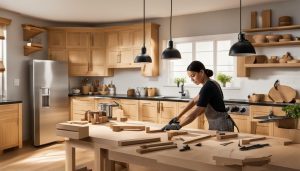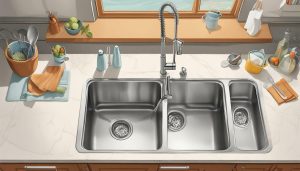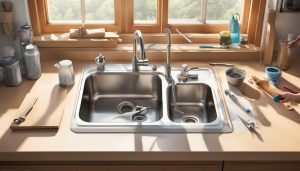Your kitchen is the heart of your home, and making it more user-friendly can greatly enhance your cooking experience. Whether you’re struggling with storage space, dealing with an awkward layout, or simply looking for ways to improve functionality, there are plenty of tips and tricks to optimize your kitchen for convenience and ease of use.
In this article, we’ll explore various ideas and strategies for making your kitchen more user-friendly, from maximizing space to incorporating ergonomic features. We’ll also provide budget-friendly options and organization tips to maintain your newly optimized kitchen. Let’s get started!
Key Takeaways:
- Improving kitchen functionality can greatly enhance your cooking experience.
- Assessing your current kitchen layout and functionality is important before making any changes.
- Maximizing kitchen space through smart storage solutions is a great way to optimize your kitchen.
- A functional kitchen layout prioritizes ease of use and efficiency and can be achieved through simple adjustments.
- Incorporating user-friendly kitchen features such as touchless faucets and smart appliances can offer added convenience.
- Kitchen accessibility is important for all users and can be achieved through proper lighting and storage accessibility.
- An ergonomic kitchen setup reduces strain and discomfort and can be achieved through adjustable countertop heights and workspace optimization.
- Personal style can be integrated into kitchen design without sacrificing functionality.
- Maintenance and organization strategies are important for maintaining a user-friendly kitchen in the long run.
- Budget-friendly options such as repurposing storage solutions and using affordable organizing tools can improve kitchen functionality.
Assessing Your Kitchen’s Current Layout and Functionality
Before making any changes to your kitchen, it’s important to assess its current layout and functionality. By doing so, you can identify areas of improvement and make adjustments that will enhance your kitchen’s accessibility and ergonomics.
Here are some kitchen organization tips to help you assess your kitchen’s current setup:
| Evaluate your workflow | Take note of how you move around your kitchen while preparing a meal. Are there any unnecessary steps or obstacles that impede your movement? |
|---|---|
| Consider accessibility | Ensure that frequently used items such as utensils and pots are easily accessible. Lower cabinets, pull-out drawers, and adjustable shelving can help improve accessibility. |
| Optimize countertop space | Make sure you have enough countertop space for meal preparation. Keep frequently used items such as cutting boards and knives within reach. |
| Think about appliance placement | Place appliances such as the refrigerator, sink, and stove in an ergonomic triangle for maximum efficiency. |
By evaluating your kitchen’s current layout and functionality, you’ll be able to identify areas of improvement and make adjustments that will improve accessibility and functionality. Keep these tips in mind as you move on to the next section and explore how to maximize your kitchen space through smart storage solutions.
Maximizing Kitchen Space Through Smart Storage Solutions
One of the biggest challenges in creating a user-friendly kitchen is maximizing space. Kitchen organization tips can help you make the most of your available space, whether you have a small kitchen or a large one. Here are some tips for organizing kitchen storage and maximizing kitchen space:
Utilize Vertical Space
One of the best ways to maximize kitchen space is to utilize vertical space. Instead of stacking items on top of one another, add shelving to walls and pantry doors. You can also invest in hanging organizers for utensils and pots and pans. By utilizing vertical space, you’ll free up valuable counter and cabinet space below.
Optimize Cabinet and Pantry Storage
If your cabinets and pantry are cluttered, it can be difficult to find what you need quickly and easily. Start by decluttering and getting rid of any items you no longer use or need. Then, invest in cabinet organizers such as pull-out drawers and racks. You can also use clear containers or labeled baskets to group similar items and keep everything organized.
Install Floating Shelves
Floating shelves are a trendy and practical addition to any kitchen. They don’t take up floor space and can be used to display cookbooks, decorative items, and even spices. Consider installing floating shelves above your countertop or stove for easy access to frequently used items.
Repurpose Existing Items
You don’t need to spend a lot of money on new storage solutions to maximize kitchen space. Look around your home for items you can repurpose as kitchen organizers, such as mason jars for utensils or a tension rod under the sink for spray bottles. Get creative with what you already have!
Label Everything
Labeling is an easy and effective way to keep your kitchen organized and maximize space. By labeling containers and baskets, you’ll know exactly what’s inside without having to dig through everything. You can use a label maker or even just a piece of masking tape and a pen.
By implementing these kitchen organization tips, you can maximize your kitchen space and make your cooking experience more enjoyable. Whether you have a small kitchen or a large one, there are plenty of ways to organize kitchen storage and improve functionality.
Streamlining Your Kitchen Workflow with a Functional Layout
Cooking in a kitchen with a poorly designed layout can be frustrating, time-consuming, and even dangerous. To overcome these issues, a functional kitchen layout should be a top priority. A well-planned layout can improve your kitchen’s functionality, making your cooking experience more efficient and enjoyable. Below are some kitchen functionality ideas to consider when designing your kitchen layout for ease of use:
Maximizing counter space
Countertop space is vital when it comes to meal preparation, cooking, and even storage. To maximize counter space, consider using materials such as granite or quartz that provide a durable and spacious work surface. If you have limited counter space, install a pull-out shelf or countertop extension to create additional space.
Placing appliances strategically
Placing appliances in the right location can save time and energy in the kitchen. Arrange appliances in a triangle pattern, with the refrigerator, stove, and sink forming the points of the triangle. This setup ensures that the main workstations are easily accessible, allowing for efficient movement during cooking and meal preparation.
Creating distinct work zones
Creating specific work zones can help streamline your kitchen workflow. Group together similar activity areas, such as storage, meal prep, cooking, and cleaning. This approach can help to keep cleaning supplies away from food, prevent clutter, and improve overall efficiency in the kitchen.
Considering traffic flow
Cooking in a tightly packed kitchen can be challenging, so it is important to consider traffic flow when designing your kitchen layout. Ensure there is plenty of space for people to move around freely, and avoid positioning your appliances or workspace in high-traffic areas.
When it comes to designing a functional kitchen layout, always put functionality first. Consider your cooking habits, lifestyle, and storage needs to create a layout that works best for you. With these kitchen functionality ideas, you can make your kitchen more functional, efficient, and enjoyable.
Incorporating User-Friendly Kitchen Features and Appliances
When it comes to making your kitchen more user-friendly, incorporating the right features and appliances can make a world of difference. Here are some kitchen functionality ideas to consider:
Touchless Faucets
Not only do touchless faucets offer a sleek and modern look, but they also offer convenience and hygiene benefits. With a simple wave of your hand, you can easily turn on the water without the need to touch the faucet handle. This is especially useful when handling raw meats or other messy ingredients.
Adjustable Shelving
Customizable shelving allows you to adjust the height of shelves to fit various items and maximize space. This is especially useful for storing larger appliances or stackable containers, giving you easy access to everything you need.
Smart Appliances
Incorporating smart appliances into your kitchen design is a great way to enhance functionality and convenience. For example, a refrigerator with a built-in touchscreen can help you manage your grocery list, control the temperature, and even play music while you cook.
LED Lighting
LED lighting can brighten up your kitchen and make it more energy-efficient. Consider adding under-cabinet lighting to illuminate your workspace and make it easier to see what you’re doing. You can even customize the color of the lighting to match your mood or the time of day.
By incorporating these user-friendly kitchen features and appliances, you can make cooking and meal prep much more efficient and enjoyable.
Incorporating User-Friendly Kitchen Features and Appliances
One of the easiest ways to make your kitchen more user-friendly is by incorporating features and appliances that offer convenience and ease of use. Here are some tips to get you started:
Touchless Faucets
One of the most user-friendly features you can add to your kitchen is a touchless faucet. These faucets use sensors to detect motion and turn on and off automatically, making them a great option for those with mobility or dexterity issues. They also help to keep your kitchen cleaner by reducing the spread of germs.
Adjustable Shelving
Adjustable shelving is another great way to make your kitchen more user-friendly. By allowing you to customize the height of your shelves, you can create more storage space and easily access items without having to stretch or bend down. This is especially important for those with limited mobility.
Smart Appliances
Smart appliances, such as refrigerators, ovens, and dishwashers, offer a range of features that can make your kitchen more convenient and efficient. For example, some smart ovens have the ability to preheat themselves and can be controlled remotely using a smartphone app. Smart refrigerators can also help you keep track of food expiration dates and can even create grocery lists for you.
Task Lighting
Having proper task lighting in your kitchen is essential for making it more user-friendly. Consider adding under-cabinet lighting, pendant lights, or track lighting to areas where you do most of your cooking and food preparation. This will ensure that you have adequate lighting and can see what you’re doing, reducing the risk of accidents or injuries.
Easy-to-Read Controls
If you’re in the market for new appliances, consider opting for ones with easy-to-read controls. Look for appliances with large, clear buttons or touchscreens, and avoid ones with complicated menus or hard-to-read displays. This will make it easier to use your appliances, even if you have vision or cognitive impairments.
Incorporating user-friendly features and appliances in your kitchen can make a big difference in your overall cooking experience. By thinking about the needs of all users, you can create a space that is efficient, convenient, and enjoyable to use.
Creating an Ergonomic Kitchen Setup for Comfort and Efficiency
When designing a user-friendly kitchen, it’s essential to prioritize comfort and efficiency in the layout and setup. An ergonomic kitchen helps to prevent strain and discomfort while cooking and performing other kitchen tasks. Here are some kitchen functionality ideas for creating an ergonomic kitchen setup:
Adjust Countertop Heights
One of the primary factors in creating an ergonomic kitchen setup is the height of your countertops. The ideal countertop height will depend on your height, but generally, it should be at a level that allows you to work comfortably without straining your back or arms. If your countertops are too low, consider placing a cutting board on top to raise the height. Similarly, if they’re too high, you may need to lower them or use a stool to reach comfortably.
Select Ergonomic Kitchen Tools
When choosing kitchen tools and utensils, opt for ergonomic designs that fit comfortably in your hand and reduce strain. For example, silicone-covered handles on pots and pans provide a non-slip grip, while angled spoons and spatulas make it easier to reach the bottom of pots and pans without straining your wrist.
Optimize Workspace
Arrange your kitchen workspace so that everything is within easy reach. This means storing frequently used items like utensils, cutting boards, and spices close to where you’ll be using them. Consider using drawer dividers and organizers to keep everything in its place and make it easy to find what you need when you need it.
Consider Appliance Placement
If you have limited space, it’s essential to think strategically about where you place your appliances. Keep frequently used appliances like the refrigerator and stove within easy reach of your main work area. You may also want to consider installing pull-out shelves or trays to make it easier to access heavier appliances like mixers and blenders.
An ergonomic kitchen setup can make a significant difference in the comfort and ease of use in your kitchen. By incorporating these kitchen design for ease of use ideas, you can reduce strain and make cooking and other kitchen tasks more enjoyable.
Designing a Kitchen That Reflects Your Personal Style
Designing your kitchen to reflect your personal style is essential in creating a space that you will love spending time in. However, it’s equally important to maintain the kitchen’s functionality. To strike a balance between aesthetics and usability, consider the following:
- Choose a color palette that complements your personal style. Use lighter colors if you have a small kitchen to create a more spacious feel.
- Integrate texture and pattern through your choice of backsplash, flooring, and countertop materials. Consider adding a rug or decorative items to add warmth and personality to the space.
- Select cabinet hardware that reflects your style. This is an easy and affordable way to add a personal touch to your kitchen.
Remember, while it’s important to express your personal style, it shouldn’t come at the expense of functionality. Choose cabinets, appliances, and countertops that fit your needs and make meal prep and cooking a breeze. By combining your personal style with functionality, you’ll create a kitchen that’s both beautiful and practical.
Maintenance and Organization Strategies for a User-Friendly Kitchen
Maintaining an organized kitchen is key to ensuring it remains user-friendly. Here are some kitchen organization tips and functionality ideas to help you keep your space clean and organized:
1. Declutter Regularly
Take the time to declutter your kitchen regularly. Get rid of expired food, broken appliances, and anything else that is no longer serving a purpose in your kitchen. This will help create more space, making it easier to stay organized.
2. Establish Cleaning Routines
Establishing regular cleaning routines will help you keep your kitchen in top condition. Make a schedule for tasks such as wiping down counters, cleaning the oven, and scrubbing the sink. Stick to your schedule to ensure your kitchen stays clean and tidy.
3. Utilize Drawer and Cabinet Organizers
Drawer and cabinet organizers are a great way to maximize kitchen storage space. Use drawer dividers to keep utensils and small items organized, and install pull-out shelves to make items in the back of cabinets more accessible.
4. Use Labels
Labels are a simple yet effective way to keep your kitchen organized. Use them to label pantry items, spice jars, and storage containers. This will help you find what you need quickly and easily, and also make it easier to put things back in their proper place.
5. Create a Command Center
Designate a specific area of your kitchen as a command center. This is where you can keep important documents, calendars, and notes. Having a command center will help keep your family organized and on the same page.
6. Keep Counters Clear
Keeping your counters clear will help create a more streamlined and functional kitchen. Try to keep only the essentials on the counter, such as a coffee maker or toaster, and put everything else away in drawers or cabinets.
7. Implement a Recycling System
Implement a recycling system in your kitchen to keep it environmentally friendly and organized. Use separate bins for plastics, paper, and glass, and take them out regularly to prevent clutter and odors.
8. Create Zones
Create specific zones in your kitchen for different tasks, such as prep, cooking, and cleaning. This will help you stay organized and make it easier to move around your kitchen. Consider the flow of traffic and arrange your zones accordingly.
9. Make Use of Vertical Space
Maximize your kitchen storage space by making use of vertical space. Install shelves or hooks on walls to hang pots, pans, and kitchen utensils. This will free up cabinet space and make your kitchen more functional.
By implementing these organization strategies, you can keep your kitchen functioning at its best, making cooking and meal prep a breeze.
Budget-Friendly Tips for Improving Kitchen Functionality
Improving your kitchen’s functionality doesn’t have to break the bank. With a little creativity and effort, you can maximize space, organize storage, and enhance usability without spending a fortune. Here are some budget-friendly ideas to get you started:
1. Repurpose Everyday Items for Storage
Look around your home for items that can be repurposed for kitchen storage. Mason jars or old coffee cans can store utensils or dry goods, while a hanging shoe organizer can be used to corral snacks or small appliances.
2. Utilize Vertical Space
If you’re short on cabinet space, consider installing shelves or using a tension rod to hang pots and pans. You can also use a pegboard to hang utensils and other kitchen tools, freeing up valuable drawer space.
3. Invest in Drawer Dividers
Drawer dividers are an affordable way to organize small items like utensils and baking tools. They also make it easy to see everything in your drawers at a glance, preventing items from getting lost or forgotten.
4. Optimize Corner Cabinets
Make the most of corner cabinets by installing a lazy Susan or pullout shelving unit. These solutions allow you to easily access items in the back of the cabinet, making use of every inch of space.
5. Use Labels
Labeling can be a simple yet effective way to keep your pantry and cabinets organized. Use a label maker or simply write on masking tape to identify the contents of each container or shelf.
6. Hang a Pegboard
A pegboard can be a versatile and affordable addition to your kitchen. Use it to hang utensils, pots and pans, or even small appliances like blenders or mixers.
With these budget-friendly tips, you can easily improve your kitchen’s functionality without spending a lot of money. Whether you’re organizing your pantry or optimizing cabinet space, a little effort can go a long way towards creating a user-friendly kitchen.
Conclusion
Creating a user-friendly kitchen is all about enhancing the functionality of the space to make cooking an easier and more enjoyable experience. By assessing your kitchen’s current layout and identifying areas of improvement, you can make adjustments that maximize space, streamline workflow, and incorporate user-friendly features and appliances.
It’s important to prioritize kitchen accessibility for all users, considering factors such as counter height and storage accessibility, while also creating an ergonomic setup that prioritizes comfort and efficiency. And don’t forget to inject your personal style into the design, while still maintaining functionality.
Maintaining a user-friendly kitchen can be achieved by implementing effective organization and cleaning strategies, and making small adjustments over time without breaking the bank. With the tips and strategies provided in this guide, you can transform your kitchen into a space that enhances your cooking experience and makes meal prep a breeze.
FAQ
Q: How can I make my kitchen more user-friendly?
A: There are several ways to make your kitchen more user-friendly. You can assess your current layout and functionality, maximize kitchen space through smart storage solutions, streamline your kitchen workflow with a functional layout, incorporate user-friendly kitchen features and appliances, enhance kitchen accessibility for all users, create an ergonomic kitchen setup for comfort and efficiency, design a kitchen that reflects your personal style, implement maintenance and organization strategies, and use budget-friendly tips to improve kitchen functionality. By considering these factors, you can create a kitchen that is organized, efficient, and easy to use.
Q: Why is it important to assess my kitchen’s current layout and functionality?
A: Assessing your kitchen’s current layout and functionality is important because it allows you to identify areas of improvement and make adjustments for better accessibility. By evaluating the efficiency of your kitchen setup, you can determine which areas are working well and which areas need improvement. This assessment will help you optimize your kitchen’s layout and functionality, resulting in a more user-friendly space.
Q: How can I maximize kitchen space through smart storage solutions?
A: You can maximize kitchen space by implementing smart storage solutions. This includes optimizing cabinet and pantry storage by using organizers, utilizing vertical space with shelves or hooks, and decluttering to create more room. By organizing your kitchen storage effectively, you can make the most of the available space and keep your kitchen neat and tidy.
Q: How can I streamline my kitchen workflow with a functional layout?
A: You can streamline your kitchen workflow by designing a functional layout. This involves considering factors such as countertop space, appliance placement, and creating distinct work zones. By organizing your kitchen in a way that enhances ease of use and efficiency, you can make cooking and preparing meals more convenient and enjoyable.
Q: What are some user-friendly kitchen features and appliances I can incorporate?
A: There are various user-friendly kitchen features and appliances you can incorporate to enhance your cooking experience. Some examples include touchless faucets, adjustable shelving, and smart appliances that offer convenience and ease of use. By choosing features and appliances that prioritize usability, you can make your kitchen more user-friendly.
Q: How can I enhance kitchen accessibility for all users?
A: You can enhance kitchen accessibility for all users by considering elements such as counter height, storage accessibility, and lighting. By making your kitchen more inclusive and accommodating to different needs, you can ensure that everyone can navigate and use the space comfortably.
Q: How can I create an ergonomic kitchen setup for comfort and efficiency?
A: Creating an ergonomic kitchen setup involves selecting ergonomic kitchen tools, adjusting countertop heights, and optimizing workspace to prevent strain and discomfort. By prioritizing comfort and efficiency in your kitchen design, you can minimize physical strain and make cooking more enjoyable.
Q: How can I design a kitchen that reflects my personal style?
A: You can design a kitchen that reflects your personal style by integrating color, texture, and decor elements that align with your aesthetic preferences. It’s important to maintain functionality while incorporating your personal style, creating a kitchen that is both visually appealing and practical.
Q: What are some maintenance and organization strategies for a user-friendly kitchen?
A: Some maintenance and organization strategies for a user-friendly kitchen include decluttering regularly, establishing cleaning routines, and creating effective organizing systems for different kitchen areas. By maintaining an organized and clean kitchen, you can ensure that it remains user-friendly in the long run.
Q: What are some budget-friendly tips for improving kitchen functionality?
A: Some budget-friendly tips for improving kitchen functionality include repurposing existing storage solutions, using affordable organizing tools, and making small adjustments to enhance usability. By being creative and resourceful, you can improve your kitchen’s functionality without breaking the bank.

It’s me, Amber Hayden, the heart and soul behind SagarmathaOnlineMedia.com. From a young age, I’ve been head over heels for everything home-related, from interior decor to gardening. I’m the type who can’t resist a well-crafted piece of furniture, and I firmly believe that a home isn’t complete without a pet or two. But it’s not just about creating pretty spaces for me. I’m all about making homes that tell a story reflecting the people living there. SagarmathaOnlineMedia.com is my way of sharing this passion with you. Whether you’re looking for tips to jazz up your living room, advice on pet care, or ideas to make your garden bloom, I’m here to help. So, let’s embark on this journey together and make your house a home!



